Memory Market Size
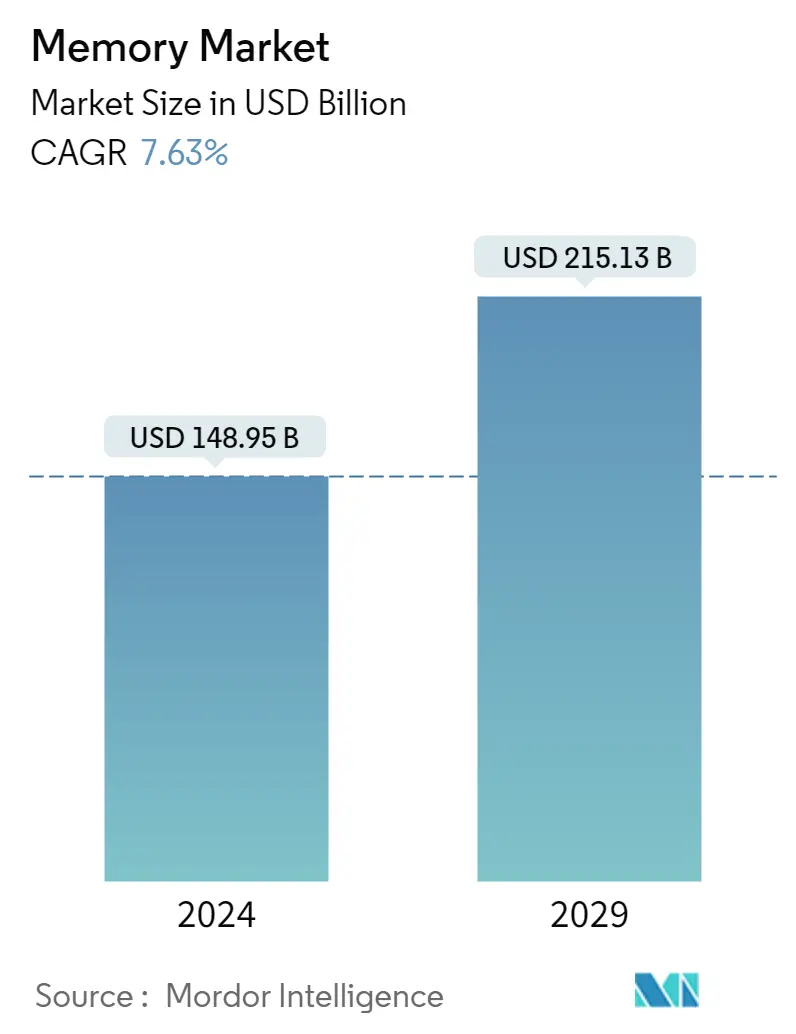
| Study Period | 2019 - 2029 |
| Market Size (2024) | USD 148.95 Billion |
| Market Size (2029) | USD 215.13 Billion |
| CAGR (2024 - 2029) | 7.63 % |
| Fastest Growing Market | Asia-Pacific |
| Largest Market | North America |
Major Players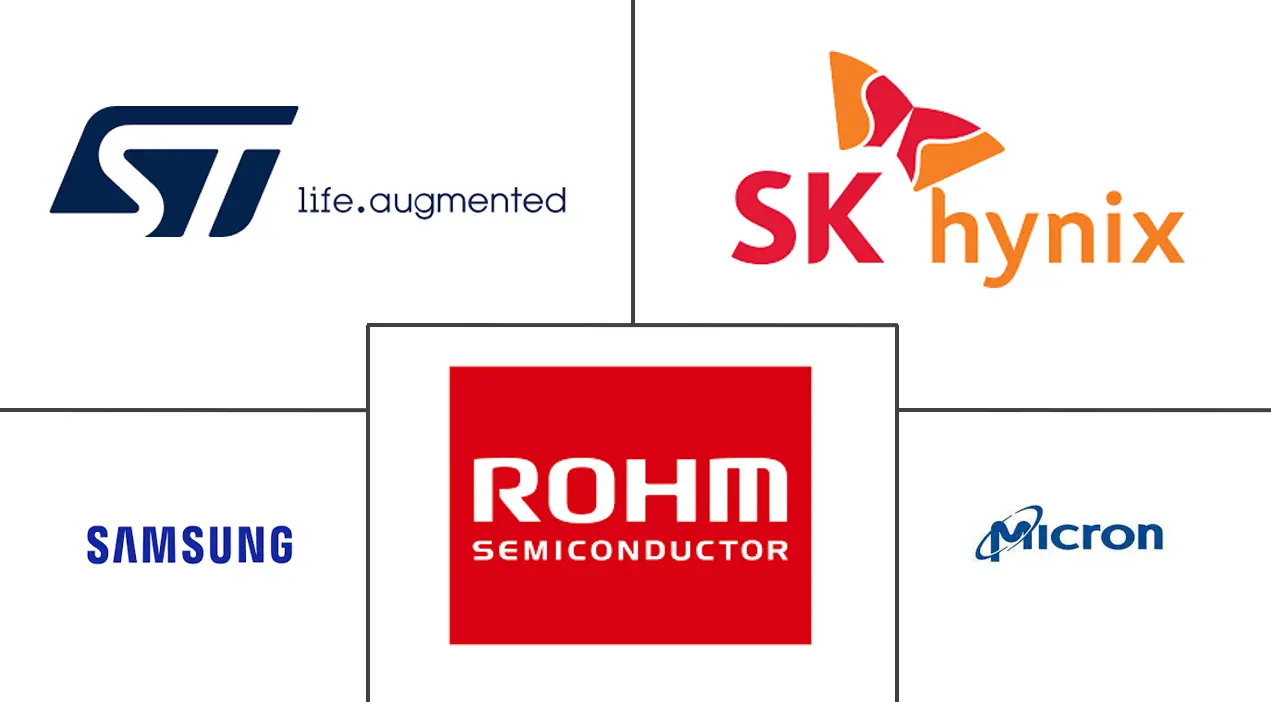
*Disclaimer: Major Players sorted in no particular order |
Memory Market Analysis
The Memory Market size is estimated at USD 148.95 billion in 2024, and is expected to reach USD 215.13 billion by 2029, growing at a CAGR of 7.63% during the forecast period (2024-2029).
The COVID-19 pandemic across the globe significantly disrupted the supply chain and production of the market studies in the initial phase of 2020. For fabrication units, this impact was more severe. Owing to the labor shortages, many of the package, assembly, and testing plants in the Asia Pacific region reduced and even suspended operations. This created a bottleneck for end-user companies that depend on semiconductors. More recently, COVID-19-related lockdowns in China again disrupted the Global Memory Market supply chain. In December 2021, Samsung Electronics and Micron Technology, two of the world's largest memory chip producers, warned that strict COVID-19 curbs and lockdowns in the Chinese city of Xian might disrupt their chip manufacturing bases in the area. According to Micron Technology, the lockdowns could cause delays in the supply of DRAM memory chips, widely used in data centers.
The memory market is witnessing rapid growth, with semiconductors emerging as the basic building blocks of most modern technologies. The innovations and advancements in this market are resulting in a direct impact on all downstream technologies.
The National Cable and Telecommunications Association projected that the number of connected devices in 2020 will be around 50.1 billion. Every IoT or IIoTdevice contains sophisticated semiconductor memory chips that permit devices to achieve remote connectivity. Moreover, as the IoT is poised to grow significantly, it is expected to impact the growth of the memory market as well.
By 2025, the market is set to experience significant benefits from the ongoing development and innovation in the automotive industry, connectivity, communications, and data centers. The rise in the consumption of electronic components used in the navigation of safety, infotainment, and automobiles further contributes to the market's growth.
Semiconductor memory products are used extensively across electronic devices, such as smartphones, flat-screen monitors, LED TVs, and civil aerospace and military systems. The memory industry is also likely to benefit from progress in biometrics capabilities. The growing demand for smartphones and technologically advanced products, such as wearable gadgets, etc., is also accelerating the growth of the market studied.
Further, several vendors are investing in this technology to gain an advantage. For instance, in April 2022, Keysight Technologies, Inc., a leading technology company that provides advanced design and validation solutions, announced that SK Hynix selected Keysight's integrated peripheral component to interconnect express (PCIe) 5.0 test platforms for speeding up the development of memory semiconductors used for designing advanced products capable of managing huge data and supporting high data speeds and.
Memory Market Trends
This section covers the major market trends shaping the Memory Market according to our research experts:
Consumer Products is Expected to Hold Significant Market Share
The emerging memory technologies have enhanced the potential of memory by allowing the storage of more data at a lesser cost than the expensive-to-build silicon chips used by popular consumer electronic gadgets, including digital cameras, cell phones, notebooks, etc.
Taiwan's United Microelectronics Corporation (UMC), a global semiconductor foundry, is providing embedded non-volatile STT-MRAM blocks based on a 28nm CMOS manufacturing process, which will enable customers to integrate low latency, very high performance, and low power embedded MRAM memory blocks into MCUs and SoCs, targeting the Internet of Things, wearable, and the consumer electronics sector.
The technological advancements in the field are driving the demand for the market studied. Companies like Nanterohave developed high-density non-volatile memory called NRAM, which is incredibly fast, offer huge amounts of storage in a small space, and consumes very little power. With Nantero'sNRAM, consumer electronics vendors can develop new consumer devices that are considered to be futuristic. With such developments, the adoption of non-volatile memory is expected to grow.
The emerging memory technologies in the sector are mainly driven by wearable and connected devices that are expected to grow at a faster pace during the forecast period. Cisco Systems estimates that the number of connected wearable devices worldwide could reach 1,105 million units by 2022.
The demand for these memory technologies is further expected to rise owing to the effective memory requirement for other consumer electronics devices such as digital cameras, smartphones, gaming devices, etc. Ericsson estimates that the shipment of smartphone units could reach 1574.4 million by 2022.
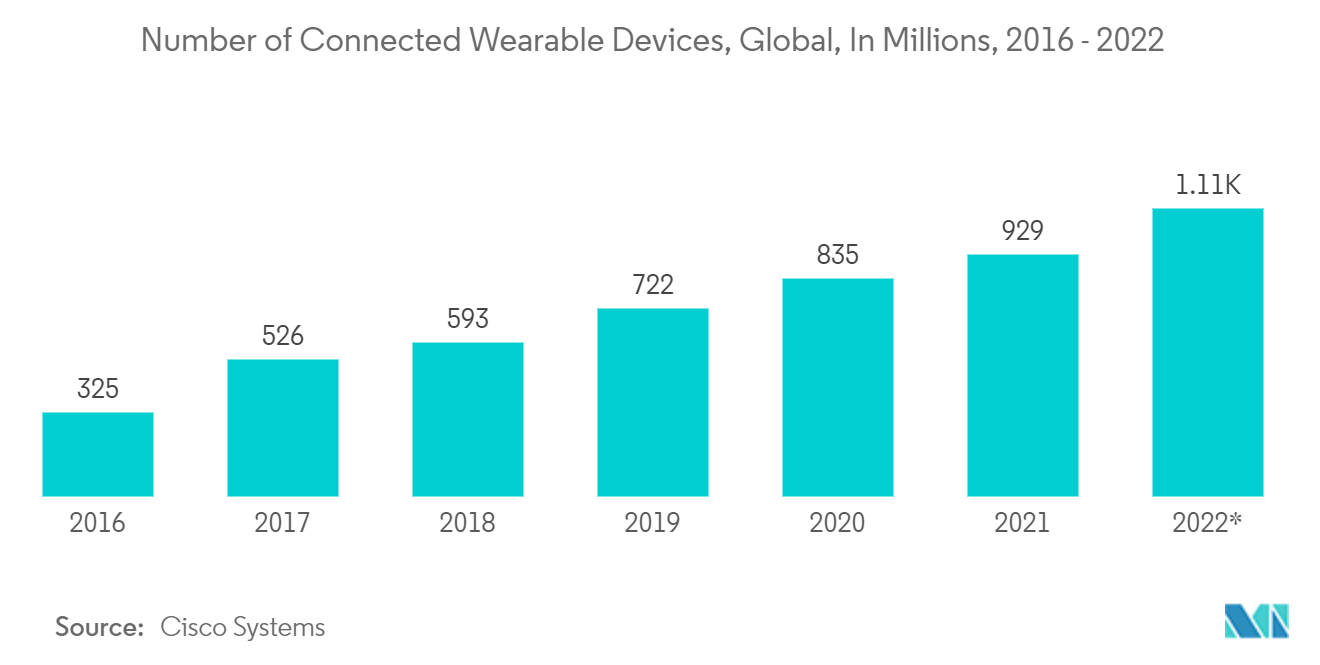
The Americas Account for the Largest Market Share
Rapidly changing technologies and high data generation across industries are creating a need for more efficient processing systems in the country. With the advent of mobile and low-power devices, as well as high-end data centers and large on-chip caches, another high-priority demand has emerged: non-volatile, dense, and low-energy-consuming memories.
In memory semiconductor manufacturing technology, the United States has regained its competitiveness in DRAM and 3D-NAND in the last few years, and US companies are fully embracing EUV (Extreme Ultraviolet).
According to the US Department of Energy, there are about 3 million data centers in the United States. The data center has become the new unit of computing. DPUs (Data Processing Units) are the essential elements of secure and modern accelerated data centers in which GPUs, CPUs, and DPUs are able to combine into a single computing unit that is fully programmable. Nvidia estimates that data management drains up to 30% of the central processing cores in data centers. The increasing demand for data centers is also boosting the demand for memory components. Currently, large data center projects in North America have contributed to the strong demand for memory, such as DRAM.
Furthermore, It is expected that 5G will enable the transmission of a huge amount of telecommunications data in a short time, which also means devices would need more storage. This would increase the adoption of NAND flash.
The US is a major market for factory automation and industrial control. FRAM offers fast random access, high read and write endurance, and low power consumption. In factory automation, the industry-standard architecture, interface, features, and packages can enable a simple drop-in solution that can eliminate the costly re-designs of the system.
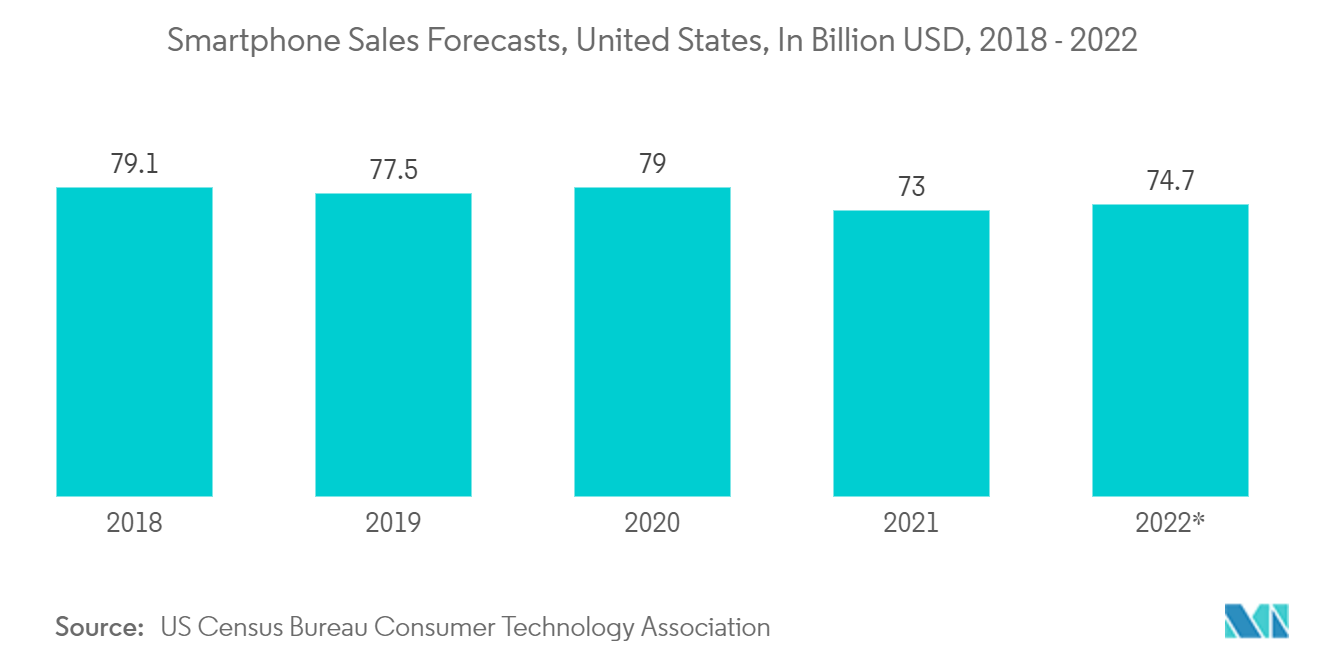
Memory Industry Overview
The Memory Market is highly competitive owing to multiple vendors providing memory to the domestic and international markets. The market appears to be moderately fragmented, with the significant vendors adopting strategies for mergers and acquisitions and strategic partnerships, among others, to expand their reach and stay competitive in the market. Some major players in the market are Samsung Electronics Co. Ltd, Micron Technology Inc., SK Hynix Inc., and ROHM Co. Ltd., among others. Some of the recent developments in the market are:
October 2021 - Micron Technology, a US-based memory manufacturer, will invest more than USD 150 billion worldwide over the next decade in advanced memory manufacturing, research, and development, including potential United States-based fab expansion.
December 2021 - Micron Technology announced an expansion of its business relationship with United Microelectronics Corporation, providing Micron the opportunities to secure supply for mobile, automotive, and critical customers into the future.
Memory Market Leaders
-
Samsung Electronics Co. Ltd
-
Micron Technology Inc.
-
SK Hynix Inc.
-
ROHM Co. Ltd.
-
STMicroelectronics NV
*Disclaimer: Major Players sorted in no particular order
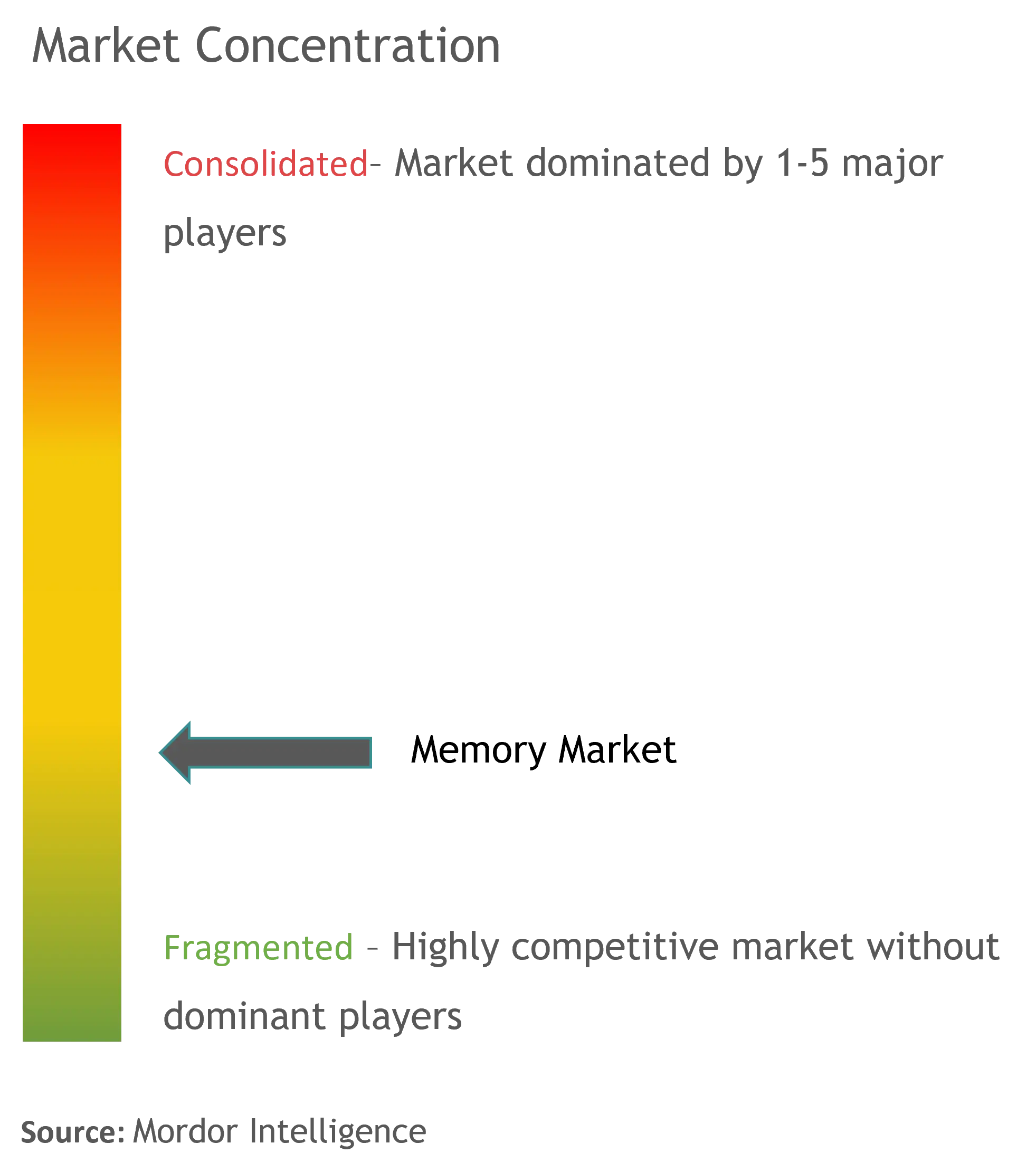
Memory Market News
- March 2022 - KioxiaCorporation, a provider of memory solutions, announced it would start construction of an advanced new fabrication facility at its KitakamiPlant in Japan for the possible expansion of manufacturing of its proprietary 3D Flash memory BiCSFLASHTM. Construction of this facility is planned to commence in April 2022 and is expected to be completed in 2023.
- December 2021 - Micron Technology announced plans for its new memory design center in Midtown Atlanta, the United States, expanding the company's reach into the Southeast United States. Micron aims to establish strong partnerships with many institutions in the region including Georgia Tech, Emory University, Spelman College Morehouse College, and the University of Georgia.
Memory Market Report - Table of Contents
1. INTRODUCTION
- 1.1 Study Assumptions and Market Definition
- 1.2 Scope of the Study
2. RESEARCH METHODOLOGY
3. EXECUTIVE SUMMARY
4. MARKET INSIGHT
- 4.1 Market Overview
-
4.2 Industry Attractiveness - Porter's Five Forces Analysis
- 4.2.1 Bargaining Power of Suppliers
- 4.2.2 Bargaining Power of Buyers
- 4.2.3 Threat of New Entrants
- 4.2.4 Threat of Substitute Products
- 4.2.5 Intensity of Competitive Rivalry
- 4.3 Technology Snapshot
- 4.4 Impact of COVID-19 on the Market
5. MARKET DYNAMICS
-
5.1 Market Drivers
- 5.1.1 Rising Penetration of 5G and IoT Devices
- 5.1.2 Growing Memory Requirement in Data Centers
- 5.1.3 Rising Demand from Consumer Electronics and Automotive Sectors
-
5.2 Market Challenges
- 5.2.1 Short term supply chain challenges due to the pandemic scenario and the US-China Trade war scenario
6. MARKET SEGMENTATION
-
6.1 By Type
- 6.1.1 DRAM
- 6.1.2 SRAM
- 6.1.3 NOR Flash
- 6.1.4 NAND Flash
- 6.1.5 ROM & EPROM
- 6.1.6 Others
-
6.2 By Application
- 6.2.1 Consumer Products
- 6.2.2 PC/Laptop
- 6.2.3 Smartphone/Tablet
- 6.2.4 Data Center
- 6.2.5 Automotive
- 6.2.6 Other Applications
-
6.3 By Geography
- 6.3.1 Americas
- 6.3.2 Europe
- 6.3.3 China
- 6.3.4 Japan
- 6.3.5 Asia-Pacific
7. COMPETITIVE LANDSCAPE
-
7.1 Company Profiles
- 7.1.1 Samsung Electronics Co. Ltd
- 7.1.2 Micron Technology Inc.
- 7.1.3 SK Hynix Inc.
- 7.1.4 ROHM Co. Ltd.
- 7.1.5 STMicroelectronics NV
- 7.1.6 Maxim Integrated Products Inc.
- 7.1.7 IBM Corporation
- 7.1.8 Cypress Semiconductor Corporation
- 7.1.9 Intel Corporation
- 7.1.10 Nvidia Corporation
- 7.1.11 Kioxia Corporation
- *List Not Exhaustive
- 7.2 Vendor Ranking
8. INVESTMENT ANALYSIS
9. FUTURE OF THE MARKET
** Subject To AvailablityMemory Industry Segmentation
The scope of the study focuses on the market analysis of semiconductor memory and market sizing encompasses the revenue generated by the memory products across the end-user industry. The study also tracks the key market parameters, underlying growth influencers, and major vendors operating in the industry, which supports the market estimations and growth rates over the forecast period. The study tracks the revenue accrued from the different memory market players operating across the world. The study further analyzes the overall impact of COVID-19 on the ecosystem.
| By Type | DRAM |
| SRAM | |
| NOR Flash | |
| NAND Flash | |
| ROM & EPROM | |
| Others | |
| By Application | Consumer Products |
| PC/Laptop | |
| Smartphone/Tablet | |
| Data Center | |
| Automotive | |
| Other Applications | |
| By Geography | Americas |
| Europe | |
| China | |
| Japan | |
| Asia-Pacific |
Memory Market Research FAQs
How big is the Memory Market?
The Memory Market size is expected to reach USD 148.95 billion in 2024 and grow at a CAGR of 7.63% to reach USD 215.13 billion by 2029.
What is the current Memory Market size?
In 2024, the Memory Market size is expected to reach USD 148.95 billion.
Who are the key players in Memory Market?
Samsung Electronics Co. Ltd, Micron Technology Inc., SK Hynix Inc., ROHM Co. Ltd. and STMicroelectronics NV are the major companies operating in the Memory Market.
Which is the fastest growing region in Memory Market?
Asia-Pacific is estimated to grow at the highest CAGR over the forecast period (2024-2029).
Which region has the biggest share in Memory Market?
In 2024, the North America accounts for the largest market share in Memory Market.
What years does this Memory Market cover, and what was the market size in 2023?
In 2023, the Memory Market size was estimated at USD 138.39 billion. The report covers the Memory Market historical market size for years: 2019, 2020, 2021, 2022 and 2023. The report also forecasts the Memory Market size for years: 2024, 2025, 2026, 2027, 2028 and 2029.
What challenges does the Memory Market face?
Key challenges faced by the Memory Market are: a) Technological complexities b) High manufacturing costs c) Need for continuous innovation to meet rapidly evolving consumer demands
What future trends are expected to shape the Memory Market?
Key future trends shaping the Memory market are: a) Development of next-generation memory technologies b) Increased focus on energy-efficient solutions c) Integration of memory products in emerging technologies like 5G
Memory Industry Report
The global memory devices market is witnessing remarkable growth, propelled by the surging demand for semiconductor memory in sectors like IT & telecom, consumer electronics, automotive, and manufacturing, due to the integration of the Internet of Things (IoT) and automation technologies. Memory companies are leading this growth, innovating to provide efficient alternatives to traditional memory storage, with a significant push towards solid-state drives and high-end data processing units. The adoption of memory chipsets in the automotive industry for Intravaginal insemination (IVI) and Advanced Driver Assistance Systems (ADAS), along with the increasing use of semiconductor memory in consumer products, especially within the IT & telecommunication segment, is opening new avenues for market expansion. The healthcare sector's digital technology adoption further fuels the demand for advanced memory solutions. The market, segmented into SRAM, DRAM, and Flash ROM, caters to diverse industry needs, underlining the continuous innovation by memory companies to meet the escalating need for high-capacity, efficient memory solutions. For detailed insights, Mordor Intelligence™ offers a comprehensive analysis, including market share, size, revenue growth rate, and a forecast outlook, available as a free report PDF download.



